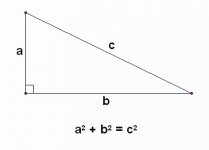You are using an out of date browser. It may not display this or other websites correctly.
You should upgrade or use an alternative browser.
You should upgrade or use an alternative browser.
Table squaring
- Thread starter Mavrik
- Start date
SMJoinery
Member
- Joined
- Nov 17, 2013
- Messages
- 522
Ok, I'm intrigued so please explain further.
I may be just a dumb ass on this kind of stuff but "a right angle on the end of a stick which is the radius of the circle", if I understand your sketch correctly wouldn't the stick if in the middle of the circle and be the same length as the radius basically redraw the circle in other words strike the edge all the way round?, so just wondered where it goes to form a corner on the circle? (I know what I mean!)
I agree about all adding to 90. 60 degrees and 30 on the other, 45/45 etc I had occasion today in the workshop for 51 degrees and turned it over and finished cut as 39 degrees. But it doesn't help square the table. If I look at the first photo from the OP the easiest way to square this edges and form or make a big square for use in the workshop is 345 method. You will end up with something looking exactly like his photo.
Sorry again if I misunderstood your post and comments.
I may be just a dumb ass on this kind of stuff but "a right angle on the end of a stick which is the radius of the circle", if I understand your sketch correctly wouldn't the stick if in the middle of the circle and be the same length as the radius basically redraw the circle in other words strike the edge all the way round?, so just wondered where it goes to form a corner on the circle? (I know what I mean!)
I agree about all adding to 90. 60 degrees and 30 on the other, 45/45 etc I had occasion today in the workshop for 51 degrees and turned it over and finished cut as 39 degrees. But it doesn't help square the table. If I look at the first photo from the OP the easiest way to square this edges and form or make a big square for use in the workshop is 345 method. You will end up with something looking exactly like his photo.
Sorry again if I misunderstood your post and comments.
cblanton42
Member
Maybe I can help here,
In order for this to work, all legs of the triangles formed would need to be the same length, right? (If not, I'm confused too)!! I think you're both arriving at the same conclusion/point but from different directions....
The radius being 90 degrees from the diameter would in effect create three equal legs, an equilateral triangle, while the 345 method creates a long and shorter side. The 345 method squares the corner at the corner, his method provides a 90 degree point across from the corner. When you connect the dots, the results are still the same. Hopefully I'm right and helped explain it! : The sketch shows the radius NOT 90 degrees from the diameter and is confusing since that is the basis for the layout!
The sketch shows the radius NOT 90 degrees from the diameter and is confusing since that is the basis for the layout!
In order for this to work, all legs of the triangles formed would need to be the same length, right? (If not, I'm confused too)!! I think you're both arriving at the same conclusion/point but from different directions....
The radius being 90 degrees from the diameter would in effect create three equal legs, an equilateral triangle, while the 345 method creates a long and shorter side. The 345 method squares the corner at the corner, his method provides a 90 degree point across from the corner. When you connect the dots, the results are still the same. Hopefully I'm right and helped explain it! :
DrD
Member
- Joined
- Mar 29, 2013
- Messages
- 390
That' s really quite nice. It does does appear to require holding some tight tolerances with lengths, centering the pivot, etc. Isn't it really much simpler (more simple) to use 4 qwas dogs - 2 for the fence and 2 for the rail? That's what I did and all my cuts have been square according to whatever methods one chooses to use for determining squareness. You can go further and do away with the mft/3 protractor and gain several inches of cutting width. This removes the need for a jig.
cblanton42
Member
Mavrik,
Your jig puts the 90 degree at the radius, your drawings put it over at the tangent. Two totally different things! Your drawings aren't possible unless all the legs are equal lengths, (and they're not), hence the confusion.
Your jig puts the 90 degree at the radius, your drawings put it over at the tangent. Two totally different things! Your drawings aren't possible unless all the legs are equal lengths, (and they're not), hence the confusion.
Similar threads
- Replies
- 0
- Views
- 331
- Replies
- 4
- Views
- 203
- Replies
- 12
- Views
- 747
- Replies
- 5
- Views
- 165






